Importance of Stakeholder Analysis and Information Management System in Business
VerifiedAdded on 2023/05/30
|7
|1690
|270
AI Summary
This article discusses the importance of stakeholder analysis and information management system in business. It covers topics such as SWOT analysis, organisational culture, and staff training. The article also provides insights into the strengths and weaknesses of software components of an information system.
Contribute Materials
Your contribution can guide someone’s learning journey. Share your
documents today.
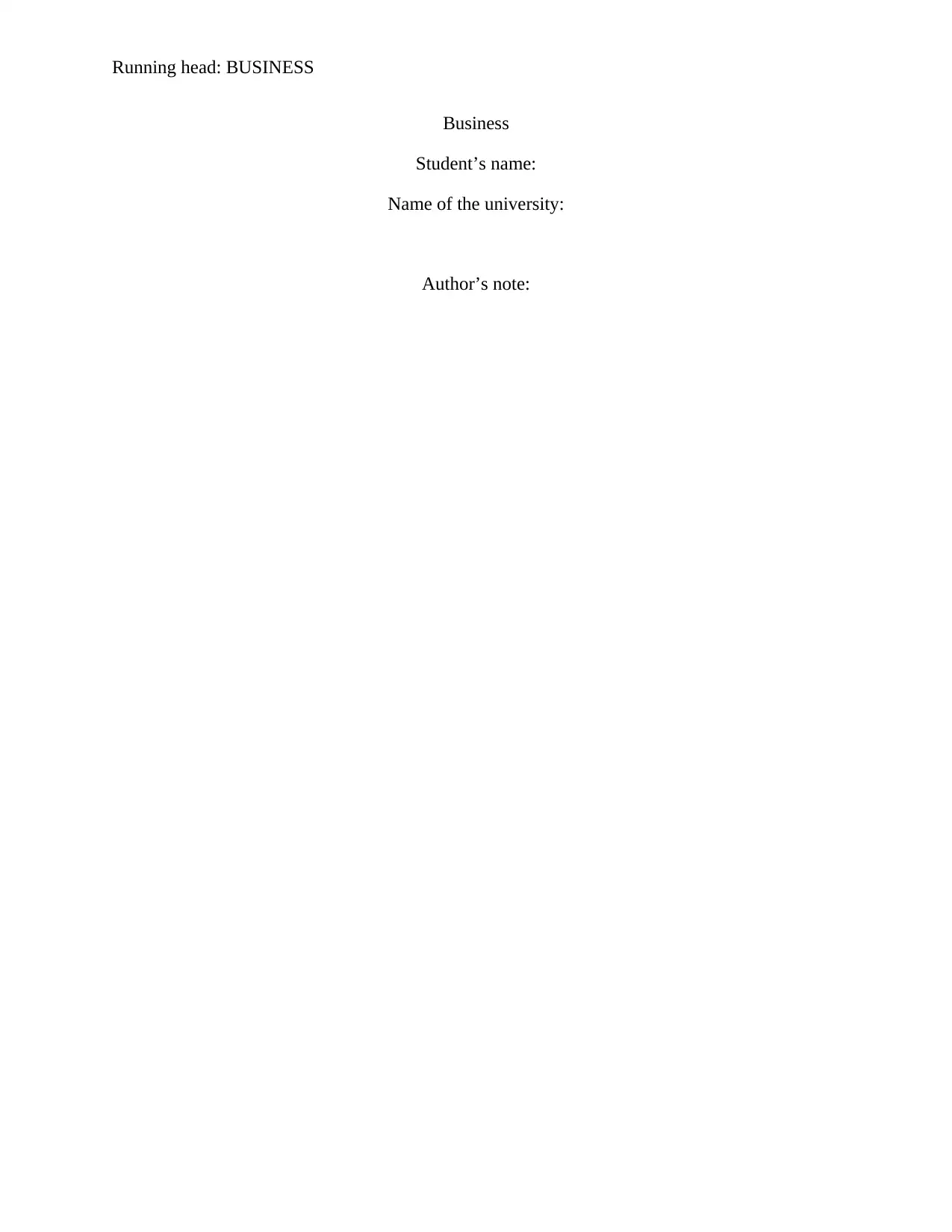
Running head: BUSINESS
Business
Student’s name:
Name of the university:
Author’s note:
Business
Student’s name:
Name of the university:
Author’s note:
Secure Best Marks with AI Grader
Need help grading? Try our AI Grader for instant feedback on your assignments.
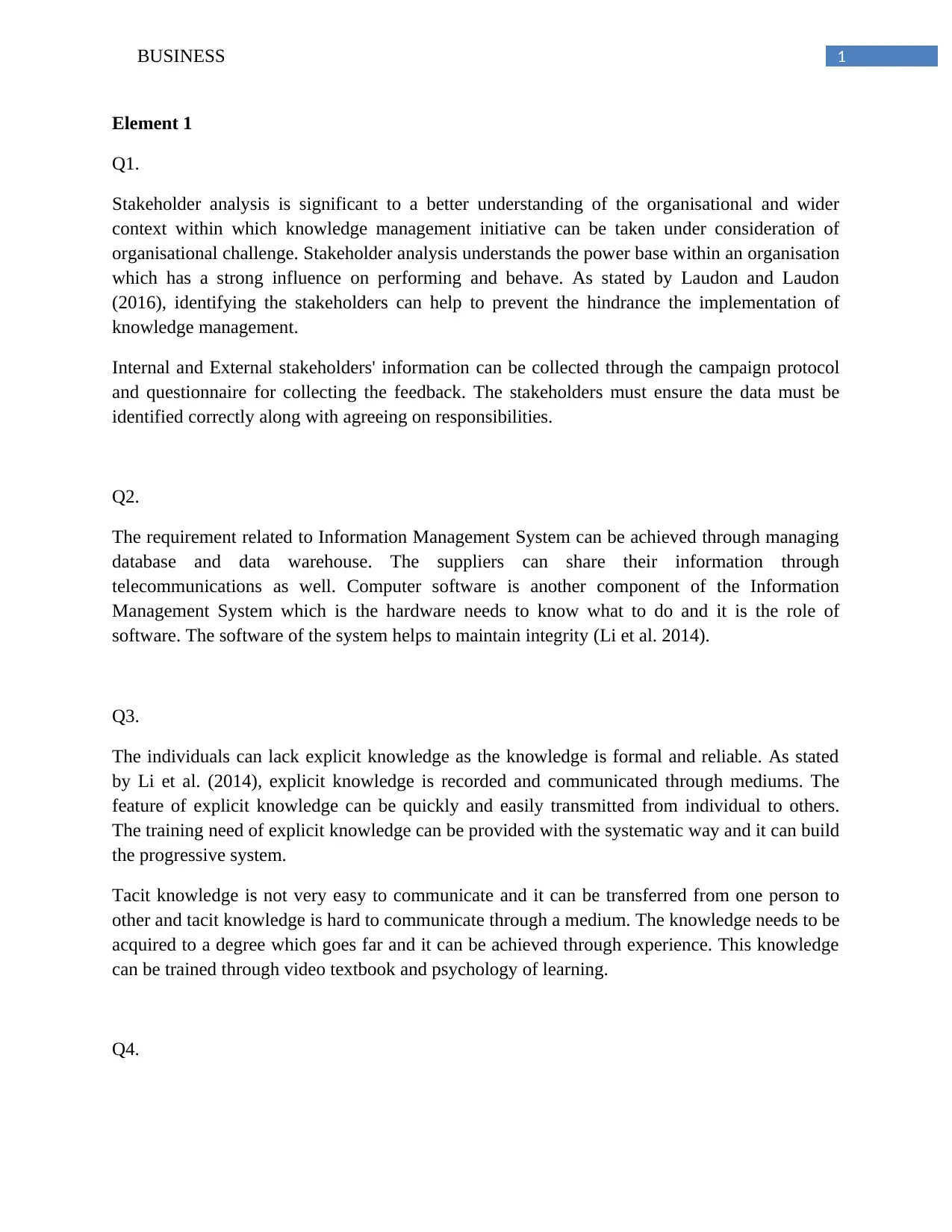
1BUSINESS
Element 1
Q1.
Stakeholder analysis is significant to a better understanding of the organisational and wider
context within which knowledge management initiative can be taken under consideration of
organisational challenge. Stakeholder analysis understands the power base within an organisation
which has a strong influence on performing and behave. As stated by Laudon and Laudon
(2016), identifying the stakeholders can help to prevent the hindrance the implementation of
knowledge management.
Internal and External stakeholders' information can be collected through the campaign protocol
and questionnaire for collecting the feedback. The stakeholders must ensure the data must be
identified correctly along with agreeing on responsibilities.
Q2.
The requirement related to Information Management System can be achieved through managing
database and data warehouse. The suppliers can share their information through
telecommunications as well. Computer software is another component of the Information
Management System which is the hardware needs to know what to do and it is the role of
software. The software of the system helps to maintain integrity (Li et al. 2014).
Q3.
The individuals can lack explicit knowledge as the knowledge is formal and reliable. As stated
by Li et al. (2014), explicit knowledge is recorded and communicated through mediums. The
feature of explicit knowledge can be quickly and easily transmitted from individual to others.
The training need of explicit knowledge can be provided with the systematic way and it can build
the progressive system.
Tacit knowledge is not very easy to communicate and it can be transferred from one person to
other and tacit knowledge is hard to communicate through a medium. The knowledge needs to be
acquired to a degree which goes far and it can be achieved through experience. This knowledge
can be trained through video textbook and psychology of learning.
Q4.
Element 1
Q1.
Stakeholder analysis is significant to a better understanding of the organisational and wider
context within which knowledge management initiative can be taken under consideration of
organisational challenge. Stakeholder analysis understands the power base within an organisation
which has a strong influence on performing and behave. As stated by Laudon and Laudon
(2016), identifying the stakeholders can help to prevent the hindrance the implementation of
knowledge management.
Internal and External stakeholders' information can be collected through the campaign protocol
and questionnaire for collecting the feedback. The stakeholders must ensure the data must be
identified correctly along with agreeing on responsibilities.
Q2.
The requirement related to Information Management System can be achieved through managing
database and data warehouse. The suppliers can share their information through
telecommunications as well. Computer software is another component of the Information
Management System which is the hardware needs to know what to do and it is the role of
software. The software of the system helps to maintain integrity (Li et al. 2014).
Q3.
The individuals can lack explicit knowledge as the knowledge is formal and reliable. As stated
by Li et al. (2014), explicit knowledge is recorded and communicated through mediums. The
feature of explicit knowledge can be quickly and easily transmitted from individual to others.
The training need of explicit knowledge can be provided with the systematic way and it can build
the progressive system.
Tacit knowledge is not very easy to communicate and it can be transferred from one person to
other and tacit knowledge is hard to communicate through a medium. The knowledge needs to be
acquired to a degree which goes far and it can be achieved through experience. This knowledge
can be trained through video textbook and psychology of learning.
Q4.
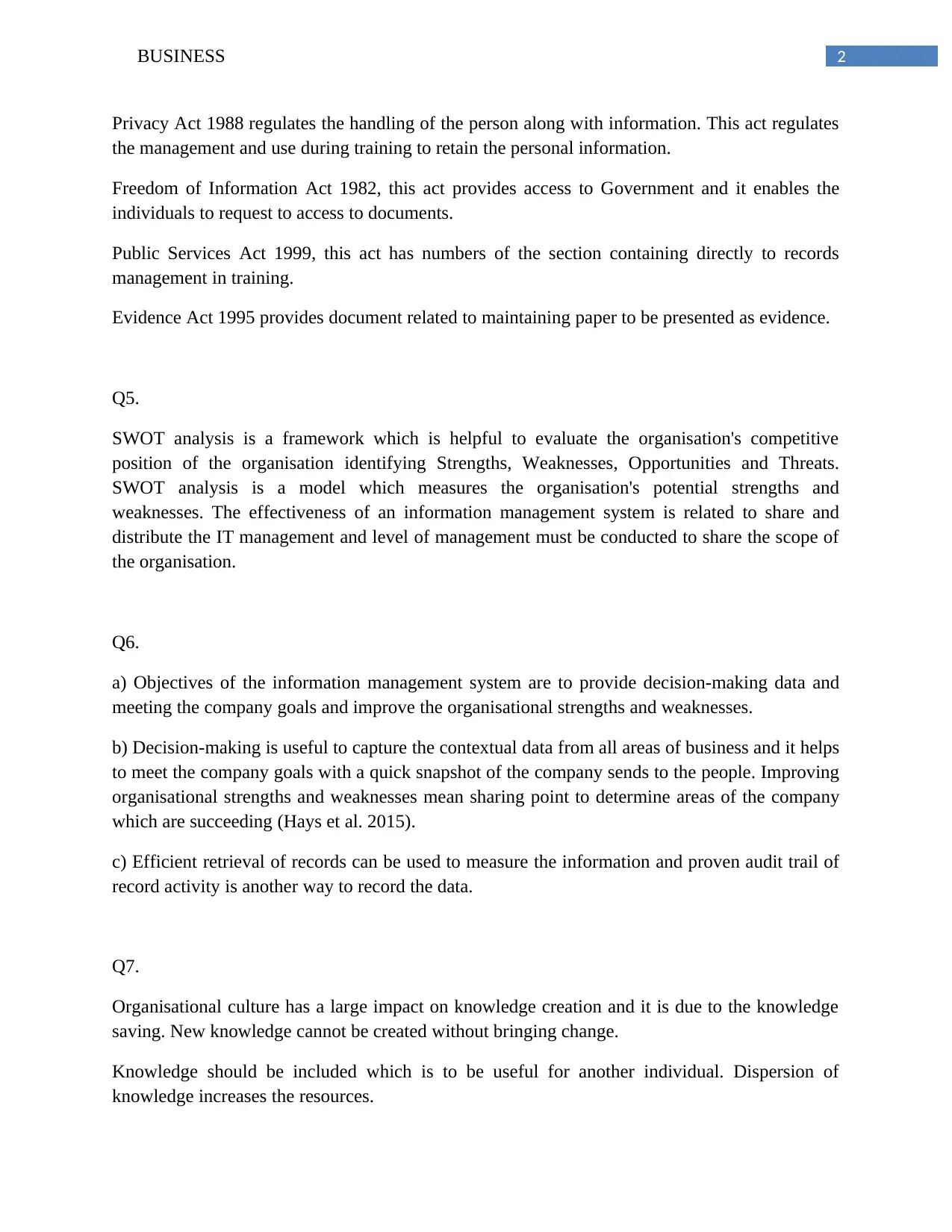
2BUSINESS
Privacy Act 1988 regulates the handling of the person along with information. This act regulates
the management and use during training to retain the personal information.
Freedom of Information Act 1982, this act provides access to Government and it enables the
individuals to request to access to documents.
Public Services Act 1999, this act has numbers of the section containing directly to records
management in training.
Evidence Act 1995 provides document related to maintaining paper to be presented as evidence.
Q5.
SWOT analysis is a framework which is helpful to evaluate the organisation's competitive
position of the organisation identifying Strengths, Weaknesses, Opportunities and Threats.
SWOT analysis is a model which measures the organisation's potential strengths and
weaknesses. The effectiveness of an information management system is related to share and
distribute the IT management and level of management must be conducted to share the scope of
the organisation.
Q6.
a) Objectives of the information management system are to provide decision-making data and
meeting the company goals and improve the organisational strengths and weaknesses.
b) Decision-making is useful to capture the contextual data from all areas of business and it helps
to meet the company goals with a quick snapshot of the company sends to the people. Improving
organisational strengths and weaknesses mean sharing point to determine areas of the company
which are succeeding (Hays et al. 2015).
c) Efficient retrieval of records can be used to measure the information and proven audit trail of
record activity is another way to record the data.
Q7.
Organisational culture has a large impact on knowledge creation and it is due to the knowledge
saving. New knowledge cannot be created without bringing change.
Knowledge should be included which is to be useful for another individual. Dispersion of
knowledge increases the resources.
Privacy Act 1988 regulates the handling of the person along with information. This act regulates
the management and use during training to retain the personal information.
Freedom of Information Act 1982, this act provides access to Government and it enables the
individuals to request to access to documents.
Public Services Act 1999, this act has numbers of the section containing directly to records
management in training.
Evidence Act 1995 provides document related to maintaining paper to be presented as evidence.
Q5.
SWOT analysis is a framework which is helpful to evaluate the organisation's competitive
position of the organisation identifying Strengths, Weaknesses, Opportunities and Threats.
SWOT analysis is a model which measures the organisation's potential strengths and
weaknesses. The effectiveness of an information management system is related to share and
distribute the IT management and level of management must be conducted to share the scope of
the organisation.
Q6.
a) Objectives of the information management system are to provide decision-making data and
meeting the company goals and improve the organisational strengths and weaknesses.
b) Decision-making is useful to capture the contextual data from all areas of business and it helps
to meet the company goals with a quick snapshot of the company sends to the people. Improving
organisational strengths and weaknesses mean sharing point to determine areas of the company
which are succeeding (Hays et al. 2015).
c) Efficient retrieval of records can be used to measure the information and proven audit trail of
record activity is another way to record the data.
Q7.
Organisational culture has a large impact on knowledge creation and it is due to the knowledge
saving. New knowledge cannot be created without bringing change.
Knowledge should be included which is to be useful for another individual. Dispersion of
knowledge increases the resources.
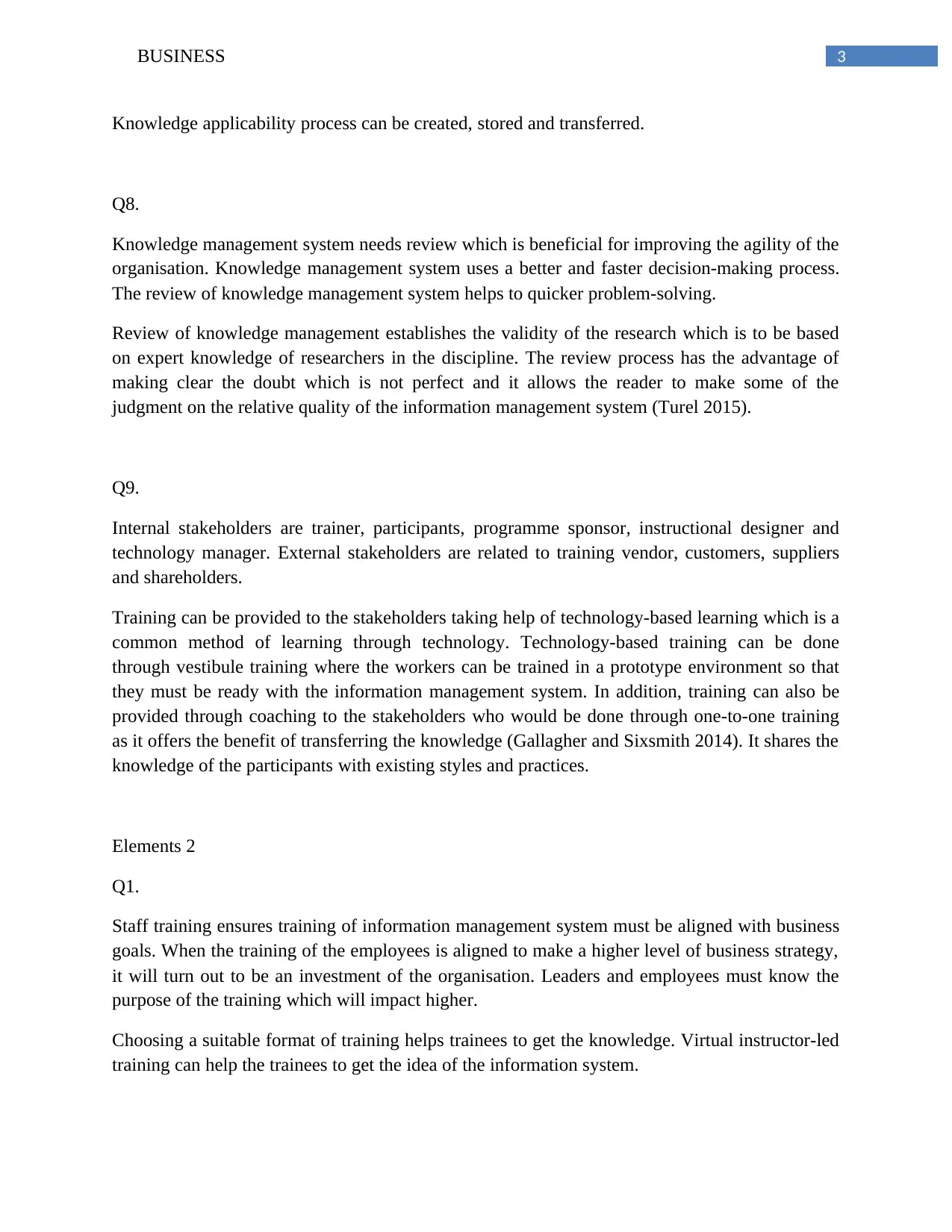
3BUSINESS
Knowledge applicability process can be created, stored and transferred.
Q8.
Knowledge management system needs review which is beneficial for improving the agility of the
organisation. Knowledge management system uses a better and faster decision-making process.
The review of knowledge management system helps to quicker problem-solving.
Review of knowledge management establishes the validity of the research which is to be based
on expert knowledge of researchers in the discipline. The review process has the advantage of
making clear the doubt which is not perfect and it allows the reader to make some of the
judgment on the relative quality of the information management system (Turel 2015).
Q9.
Internal stakeholders are trainer, participants, programme sponsor, instructional designer and
technology manager. External stakeholders are related to training vendor, customers, suppliers
and shareholders.
Training can be provided to the stakeholders taking help of technology-based learning which is a
common method of learning through technology. Technology-based training can be done
through vestibule training where the workers can be trained in a prototype environment so that
they must be ready with the information management system. In addition, training can also be
provided through coaching to the stakeholders who would be done through one-to-one training
as it offers the benefit of transferring the knowledge (Gallagher and Sixsmith 2014). It shares the
knowledge of the participants with existing styles and practices.
Elements 2
Q1.
Staff training ensures training of information management system must be aligned with business
goals. When the training of the employees is aligned to make a higher level of business strategy,
it will turn out to be an investment of the organisation. Leaders and employees must know the
purpose of the training which will impact higher.
Choosing a suitable format of training helps trainees to get the knowledge. Virtual instructor-led
training can help the trainees to get the idea of the information system.
Knowledge applicability process can be created, stored and transferred.
Q8.
Knowledge management system needs review which is beneficial for improving the agility of the
organisation. Knowledge management system uses a better and faster decision-making process.
The review of knowledge management system helps to quicker problem-solving.
Review of knowledge management establishes the validity of the research which is to be based
on expert knowledge of researchers in the discipline. The review process has the advantage of
making clear the doubt which is not perfect and it allows the reader to make some of the
judgment on the relative quality of the information management system (Turel 2015).
Q9.
Internal stakeholders are trainer, participants, programme sponsor, instructional designer and
technology manager. External stakeholders are related to training vendor, customers, suppliers
and shareholders.
Training can be provided to the stakeholders taking help of technology-based learning which is a
common method of learning through technology. Technology-based training can be done
through vestibule training where the workers can be trained in a prototype environment so that
they must be ready with the information management system. In addition, training can also be
provided through coaching to the stakeholders who would be done through one-to-one training
as it offers the benefit of transferring the knowledge (Gallagher and Sixsmith 2014). It shares the
knowledge of the participants with existing styles and practices.
Elements 2
Q1.
Staff training ensures training of information management system must be aligned with business
goals. When the training of the employees is aligned to make a higher level of business strategy,
it will turn out to be an investment of the organisation. Leaders and employees must know the
purpose of the training which will impact higher.
Choosing a suitable format of training helps trainees to get the knowledge. Virtual instructor-led
training can help the trainees to get the idea of the information system.
Paraphrase This Document
Need a fresh take? Get an instant paraphrase of this document with our AI Paraphraser
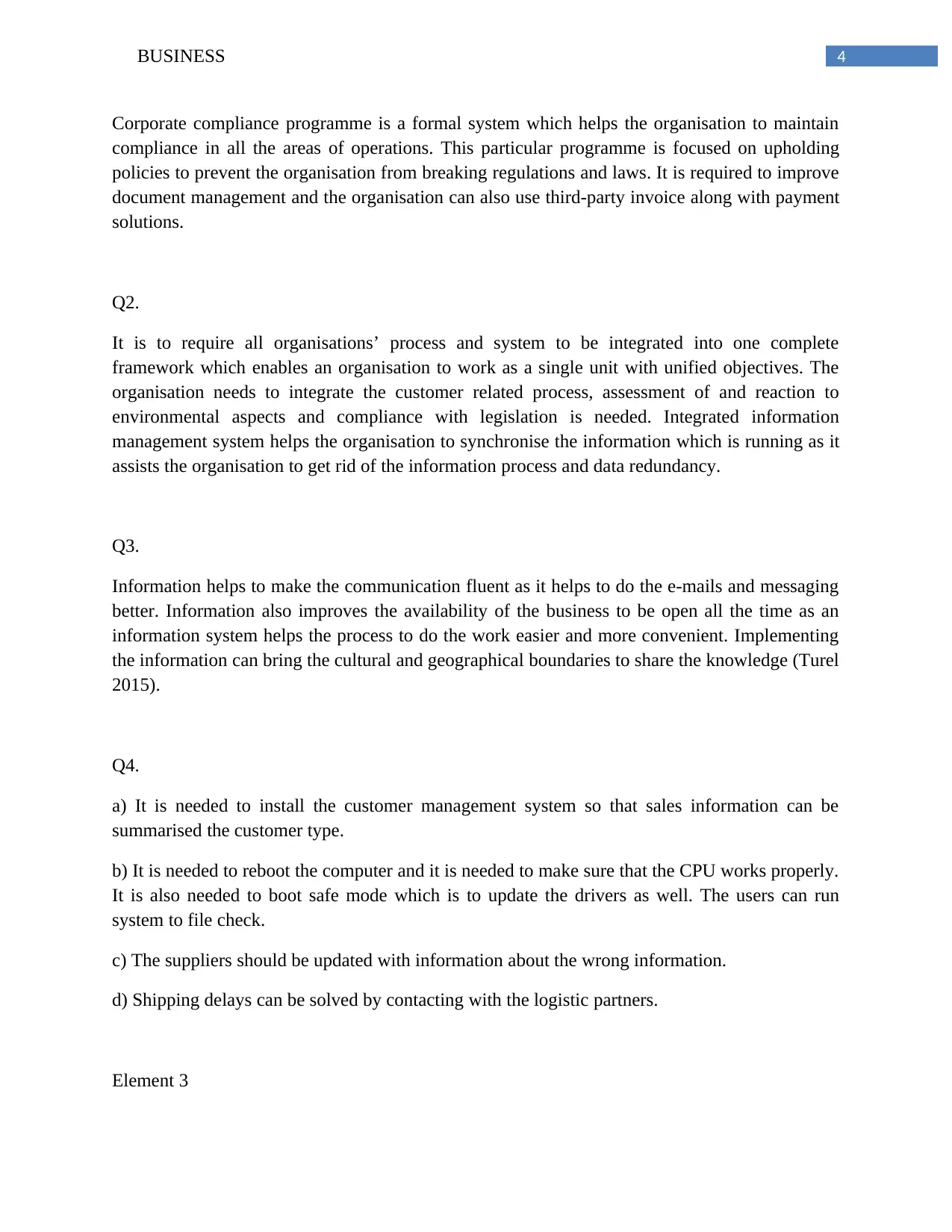
4BUSINESS
Corporate compliance programme is a formal system which helps the organisation to maintain
compliance in all the areas of operations. This particular programme is focused on upholding
policies to prevent the organisation from breaking regulations and laws. It is required to improve
document management and the organisation can also use third-party invoice along with payment
solutions.
Q2.
It is to require all organisations’ process and system to be integrated into one complete
framework which enables an organisation to work as a single unit with unified objectives. The
organisation needs to integrate the customer related process, assessment of and reaction to
environmental aspects and compliance with legislation is needed. Integrated information
management system helps the organisation to synchronise the information which is running as it
assists the organisation to get rid of the information process and data redundancy.
Q3.
Information helps to make the communication fluent as it helps to do the e-mails and messaging
better. Information also improves the availability of the business to be open all the time as an
information system helps the process to do the work easier and more convenient. Implementing
the information can bring the cultural and geographical boundaries to share the knowledge (Turel
2015).
Q4.
a) It is needed to install the customer management system so that sales information can be
summarised the customer type.
b) It is needed to reboot the computer and it is needed to make sure that the CPU works properly.
It is also needed to boot safe mode which is to update the drivers as well. The users can run
system to file check.
c) The suppliers should be updated with information about the wrong information.
d) Shipping delays can be solved by contacting with the logistic partners.
Element 3
Corporate compliance programme is a formal system which helps the organisation to maintain
compliance in all the areas of operations. This particular programme is focused on upholding
policies to prevent the organisation from breaking regulations and laws. It is required to improve
document management and the organisation can also use third-party invoice along with payment
solutions.
Q2.
It is to require all organisations’ process and system to be integrated into one complete
framework which enables an organisation to work as a single unit with unified objectives. The
organisation needs to integrate the customer related process, assessment of and reaction to
environmental aspects and compliance with legislation is needed. Integrated information
management system helps the organisation to synchronise the information which is running as it
assists the organisation to get rid of the information process and data redundancy.
Q3.
Information helps to make the communication fluent as it helps to do the e-mails and messaging
better. Information also improves the availability of the business to be open all the time as an
information system helps the process to do the work easier and more convenient. Implementing
the information can bring the cultural and geographical boundaries to share the knowledge (Turel
2015).
Q4.
a) It is needed to install the customer management system so that sales information can be
summarised the customer type.
b) It is needed to reboot the computer and it is needed to make sure that the CPU works properly.
It is also needed to boot safe mode which is to update the drivers as well. The users can run
system to file check.
c) The suppliers should be updated with information about the wrong information.
d) Shipping delays can be solved by contacting with the logistic partners.
Element 3
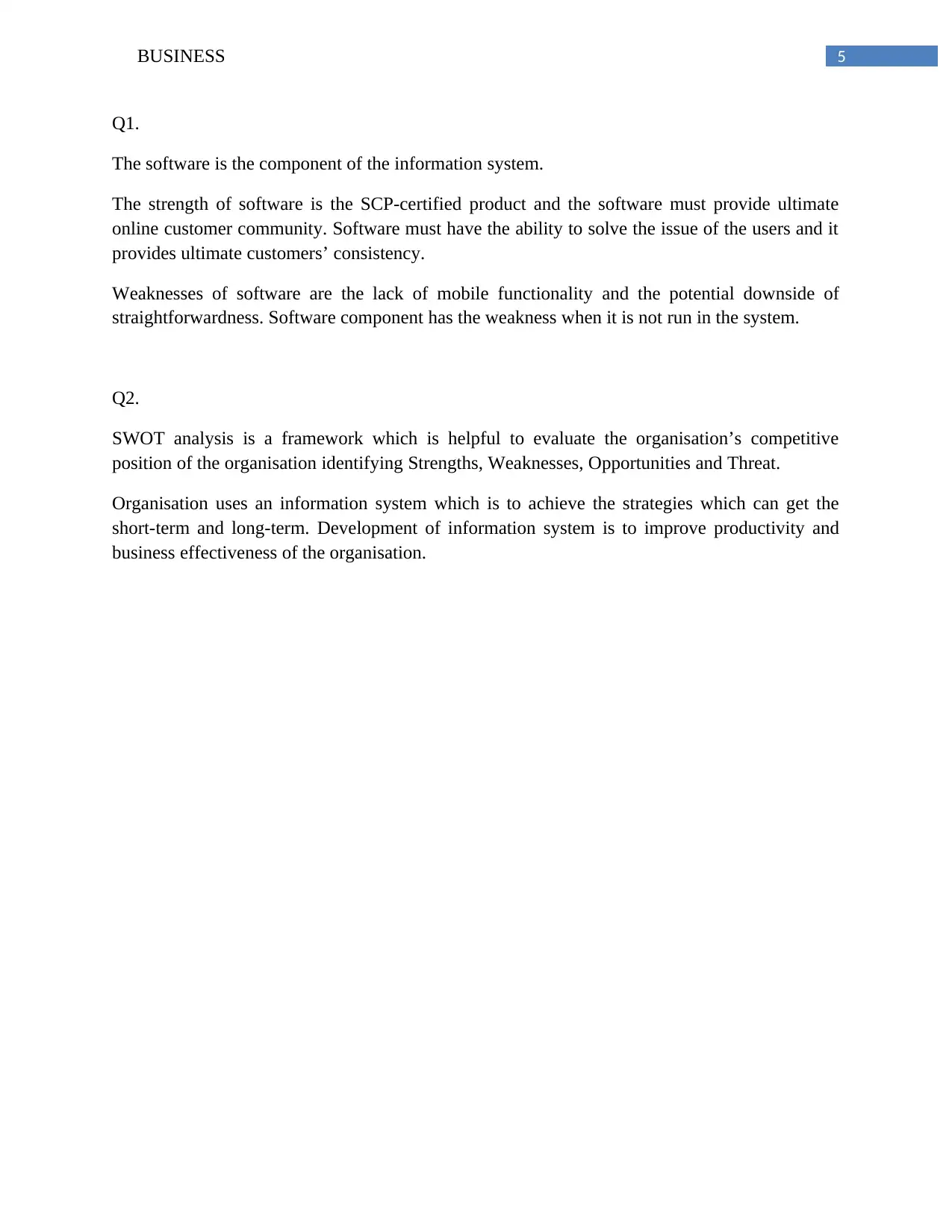
5BUSINESS
Q1.
The software is the component of the information system.
The strength of software is the SCP-certified product and the software must provide ultimate
online customer community. Software must have the ability to solve the issue of the users and it
provides ultimate customers’ consistency.
Weaknesses of software are the lack of mobile functionality and the potential downside of
straightforwardness. Software component has the weakness when it is not run in the system.
Q2.
SWOT analysis is a framework which is helpful to evaluate the organisation’s competitive
position of the organisation identifying Strengths, Weaknesses, Opportunities and Threat.
Organisation uses an information system which is to achieve the strategies which can get the
short-term and long-term. Development of information system is to improve productivity and
business effectiveness of the organisation.
Q1.
The software is the component of the information system.
The strength of software is the SCP-certified product and the software must provide ultimate
online customer community. Software must have the ability to solve the issue of the users and it
provides ultimate customers’ consistency.
Weaknesses of software are the lack of mobile functionality and the potential downside of
straightforwardness. Software component has the weakness when it is not run in the system.
Q2.
SWOT analysis is a framework which is helpful to evaluate the organisation’s competitive
position of the organisation identifying Strengths, Weaknesses, Opportunities and Threat.
Organisation uses an information system which is to achieve the strategies which can get the
short-term and long-term. Development of information system is to improve productivity and
business effectiveness of the organisation.
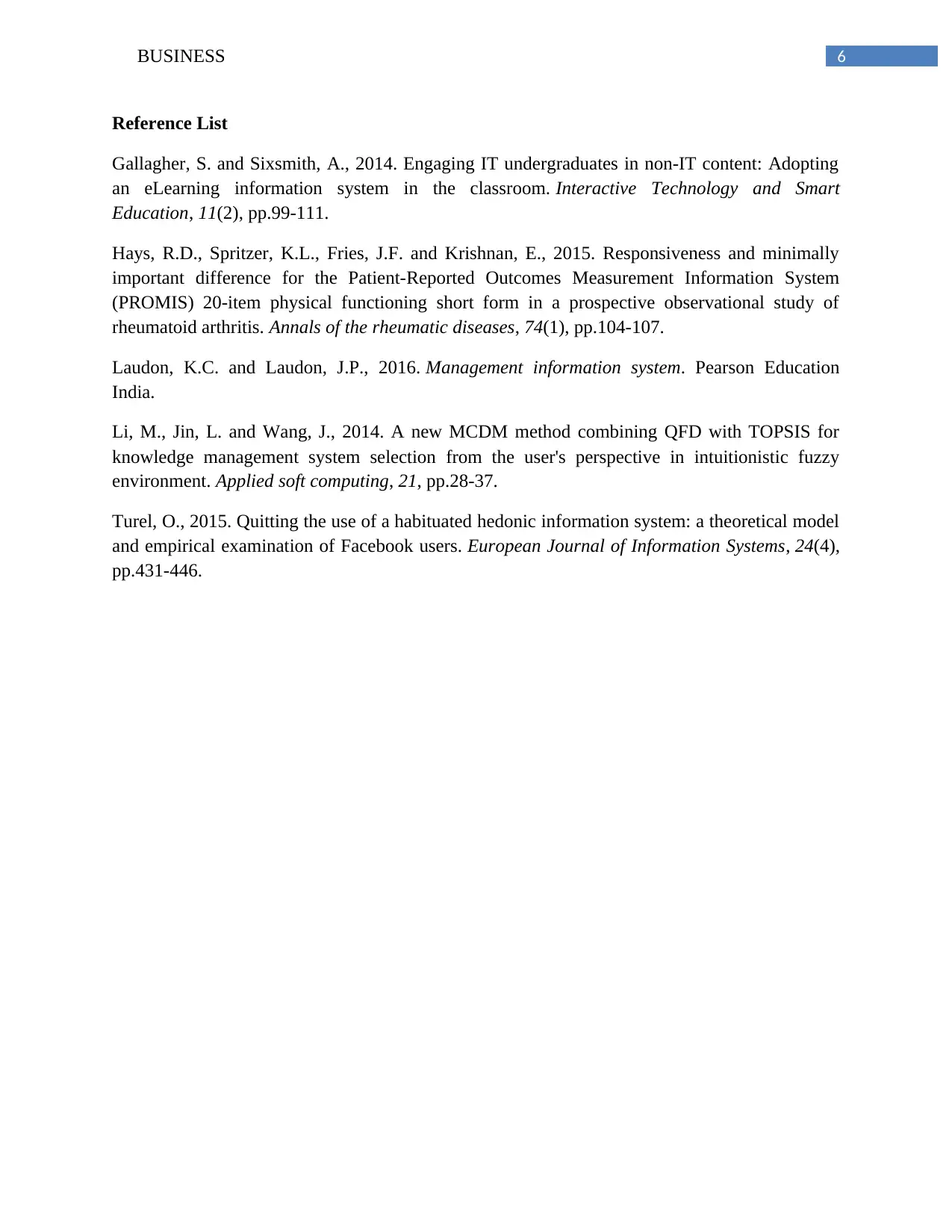
6BUSINESS
Reference List
Gallagher, S. and Sixsmith, A., 2014. Engaging IT undergraduates in non-IT content: Adopting
an eLearning information system in the classroom. Interactive Technology and Smart
Education, 11(2), pp.99-111.
Hays, R.D., Spritzer, K.L., Fries, J.F. and Krishnan, E., 2015. Responsiveness and minimally
important difference for the Patient-Reported Outcomes Measurement Information System
(PROMIS) 20-item physical functioning short form in a prospective observational study of
rheumatoid arthritis. Annals of the rheumatic diseases, 74(1), pp.104-107.
Laudon, K.C. and Laudon, J.P., 2016. Management information system. Pearson Education
India.
Li, M., Jin, L. and Wang, J., 2014. A new MCDM method combining QFD with TOPSIS for
knowledge management system selection from the user's perspective in intuitionistic fuzzy
environment. Applied soft computing, 21, pp.28-37.
Turel, O., 2015. Quitting the use of a habituated hedonic information system: a theoretical model
and empirical examination of Facebook users. European Journal of Information Systems, 24(4),
pp.431-446.
Reference List
Gallagher, S. and Sixsmith, A., 2014. Engaging IT undergraduates in non-IT content: Adopting
an eLearning information system in the classroom. Interactive Technology and Smart
Education, 11(2), pp.99-111.
Hays, R.D., Spritzer, K.L., Fries, J.F. and Krishnan, E., 2015. Responsiveness and minimally
important difference for the Patient-Reported Outcomes Measurement Information System
(PROMIS) 20-item physical functioning short form in a prospective observational study of
rheumatoid arthritis. Annals of the rheumatic diseases, 74(1), pp.104-107.
Laudon, K.C. and Laudon, J.P., 2016. Management information system. Pearson Education
India.
Li, M., Jin, L. and Wang, J., 2014. A new MCDM method combining QFD with TOPSIS for
knowledge management system selection from the user's perspective in intuitionistic fuzzy
environment. Applied soft computing, 21, pp.28-37.
Turel, O., 2015. Quitting the use of a habituated hedonic information system: a theoretical model
and empirical examination of Facebook users. European Journal of Information Systems, 24(4),
pp.431-446.
1 out of 7
![[object Object]](/_next/static/media/star-bottom.7253800d.svg)





